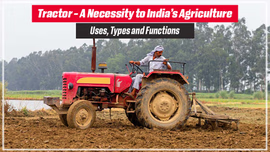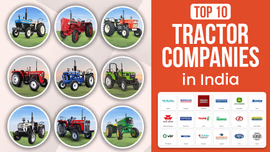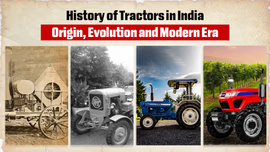Everything you need to know about Tractor Steering

Table of Contents
- Introduction
- What is the Role of Steering System in Tractors?
- What are the Key Components of a Tractor Steering System?
- What are the Types of Tractor Steering Systems?
- What are the Benefits of Power Steering in Tractors?
- What is the Difference between Power and Manual Steering?
- Advancement in Steering Systems
- How to Choose the Right Steering System?
Introduction
Steering is one of the important components of a tractor, as it controls the tractor's overall movement. The steering system converts the steering wheel rotation into a change of angle of the axis of the steering wheel. It is only possible if your tractor has a good steering system that will allow you to drive comfortably for long working hours and thereby increase your productivity. To ensure farm operations are done comfortably, companies are offering new technologies to enhance the Indian farming sector.
What is the Role of Steering System in Tractors?
A steering system governs the tractor's front wheels' angular movement. The driver's effort to change the direction of the tractor depends upon the type of steering. This change is done through a complex series of links and components, converting rotational input from the steering wheel into a change in the angle of the front wheels. The force produced through it is passed to the front wheels, dictating the tractor's route. It ensures direction stability, allowing operators to maintain precision and control in different field conditions. A well-designed steering system can reduce wear on the tractor's tyres, ensuring the efficiency and longevity of the tractor.
What are the Key Components of a Tractor Steering System?
- Steering Wheel
- Steering Gear
- Steering Shaft
- Drop Arm (Pitman Arm)
- Steering Arm
- Drag Link
- King Pin
- Tie Rod
What are the Types of Tractor Steering Systems?
Manual Steering System
These are traditional and simpler types of steering systems usually offered in old tractors. This steering system relies on mechanical linkages, such as gears, steering columns, and rods. The steering wheel directly controls the front wheels' movement and requires physical force from the operator. Its maintenance cost is low because of its simple design, and it has a cheaper cost. That's why farmers still prefer this type of steering system. However, it requires more physical force than other types of steering, resulting in operator fatigue.
Power Steering System
Power Steering system is a more advanced technology than manual steering system, which uses hydraulic pressure to control the movement of the tractor. It is widely used in new-age tractors because of its smooth handling, and the operator needs to apply less physical force to turn the tractor than manual steering. However, its maintenance cost could be slightly higher than that of manual steering, but it’s a completely value-for-money upgrade. The power steering system comes in two types:
- Hydraulic Power Steering
- Hydrostatic Power Steering
Let’s discuss each in detail.
Hydraulic Power Steering
This type of power steering is hydraulically boosted and has a complete mechanical link between the steering wheel and the front tyres. It is further divided into two types:
- Single-Acting Power Steering: Single-acting power steering features a hydraulic cylinder connected to one front wheel through a piston rod. Thus, the power is transmitted to one wheel and then supplied to the other wheel.
- Dual-Acting Power Steering: Dual-acting power steering features a hydraulic cylinder connected to both front wheels through two piston rods on both sides, providing power to both front wheels simultaneously. It offers smoother handling than single-acting power steering.
Hydrostatic Power Steering
This steering system is fully hydraulically driven and does not require mechanical steering linkage. It uses a steering unit, steering cylinders, and flexible hoses. It offers smooth handling and better control of the tractor on varied terrains.
Electric Power Steering System
An electric power steering system has gained popularity because of its efficiency and ease of integration with modern tractors. It uses an electric motor for steering mechanization. It is popular for its responsiveness and ability to adjust steering efforts according to operating conditions.
What are the Benefits of Power Steering in Tractors?
- It reduces operator fatigue by offering an effortless handling experience.
- It allows farmers to work for longer hours, thereby helping to cover more ground and increasing profitability.
- It offers accurate and better steering control while operating trolleys, reducing accident possibilities and increasing safety.
- It also provides better control while driving in muddy conditions.
What is the Difference between Power and Manual Steering?
|
|
Power Steering |
Manual Steering |
|
Effort Required |
It requires less effort from the operator to turn the tractor. |
It requires more physical effort to turn the tractor. |
|
Driver Fatigue |
It reduces driver fatigue during long working hours. |
You may experience more fatigue during long working hours. |
|
Maneuverability |
It offers smoother and more precise control of the tractor. |
The driver may feel heavier and less precise while operating a manual steering tractor. |
|
Accessibility |
A power-steering tractor can be operated by any individual with varying physical capabilities. |
Operating a manual-steering tractor can be challenging for some drivers. |
|
Price |
It has a comparatively higher price because of the added components in the steering system. |
Its cost is low because of its simple design. |
Advancement in Steering Systems
John Deere recently launched a new technology called AutoTrac and is offering it in some of its high-power tractors. This advanced technology is provided in the steering system, which automatically turns the steering wheel to keep the tractor on the predefined route. This feature ensures the tractor moves on a selected guidance line.
How to Choose the Right Steering System?
There is a myth among farmers that opting for a manual-steering tractor will help them save a good amount of money on maintenance. However, this is not the case. Power steering might have more maintenance costs, but it is worth the investment because of its comfort. Moreover, technology is advancing daily, so buying a tractor with power steering is a good decision. It allows long working hours without fatigue, resulting in more productivity and profit.
We recommend buying a tractor with power steering. Visit Tractorkarvan to learn more about the steering systems offered in different tractor models. Additionally, if you are planning to buy a tractor and need help with funds, then use our tractor loan facility. We offer both new and second-hand tractor loans.


Related Blogs












